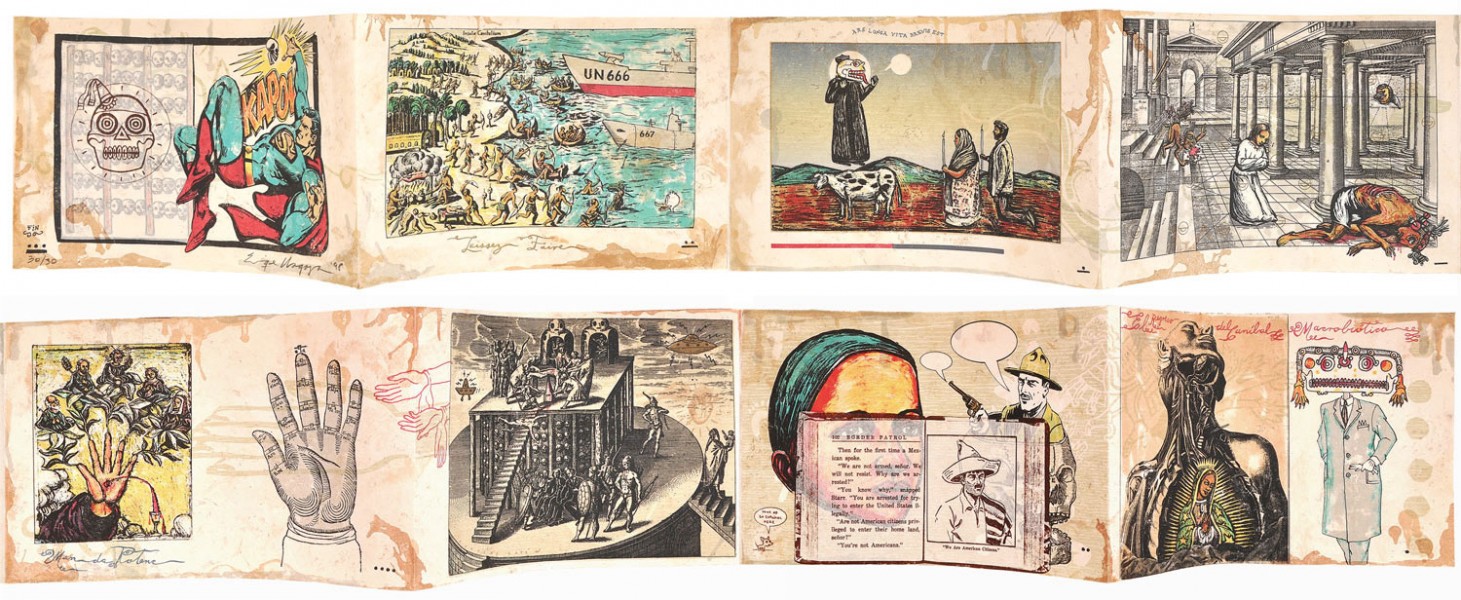Social Justice Collection
El Regresso del Canibal Macrobiotico
Enrique Chagoya
American, b. Mexico, 1953
1998
Lithograph, woodcut, chine collé
Printer and publisher: Shark's Ink, Boulder, Colorado
99.01
SSWB 4684 (Warner Room)
Born in Mexico and raised on Pre-Columbian monuments, Catholicism, and Superman, Enrique Chagoya deploys these cultural entities and others in his politically oriented yet humorous art. Chagoya practices ‘reverse anthropology’ in which he quotes texts, symbols, and images and combines them in unexpected ways to address the clash of cultures in the contemporary global world. The format of El Regresso del Canibal Macrobiotico or The Return of the Macrobiotic Cannibal, is one example of an anthropological quotation. It is a codex, a Pre-Columbian accordion-fold book which is read from right to left and is made of the same bark, amate, paper as the ancient books. Most codices were destroyed during and after the colonial period but Chagoya pays homage to them in form as well as imagery in much of his work. Many elements within his corpus are pulled from remaining codices such as the fire-spitting demon from the Borgia Codex seen within plans for a Renaissance building in the fifth panel and here.
Examples of layering texts and the excavation required to understand them abound in this piece. At the opening, Chagoya inserts the Virgin of Guadalupe, who many believe is a synthesis of Catholicism and the Aztec goddess Tonantzin, into a diagram of the muscular system. Elsewhere, a trio of European men stand before a platform over a pile of skulls while cartoon UFOs float in the sky. In the penultimate panel, two naval vessels entitled UN 666 and 667, along with the head of Donald Duck, float toward a shore teeming with indigenous warriors. United Nations Security Council resolutions 666 and 667 date to 1990 and concern the Iraqi invasion and UN sanctions against Saddam Hussein’s detention of foreigners. The text below the panel reads “laissez faire.” In the last panel, Superman has been punched by an Aztec skull. Chagoya’s juxtapositions, layering, and rearranging of cultural icons act as Interventions on collective memory and reflect the complexity of local and global community in the 21st century. Each element has a meaning in isolation but in combination and in the sweep of the whole, meaning is more complex.
Examples of layering texts and the excavation required to understand them abound in this piece. At the opening, Chagoya inserts the Virgin of Guadalupe, who many believe is a synthesis of Catholicism and the Aztec goddess Tonantzin, into a diagram of the muscular system. Elsewhere, a trio of European men stand before a platform over a pile of skulls while cartoon UFOs float in the sky. In the penultimate panel, two naval vessels entitled UN 666 and 667, along with the head of Donald Duck, float toward a shore teeming with indigenous warriors. United Nations Security Council resolutions 666 and 667 date to 1990 and concern the Iraqi invasion and UN sanctions against Saddam Hussein’s detention of foreigners. The text below the panel reads “laissez faire.” In the last panel, Superman has been punched by an Aztec skull. Chagoya’s juxtapositions, layering, and rearranging of cultural icons act as Interventions on collective memory and reflect the complexity of local and global community in the 21st century. Each element has a meaning in isolation but in combination and in the sweep of the whole, meaning is more complex.

